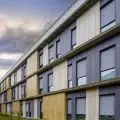Microbiological and chemical laboratory,
design: Penelas Architects
The laboratory, designed by the architectural firm Penelas Architects, under the leadership of José Luis Esteban Penelas, serves as a center for microbiological and chemical research, providing analytical, control and consulting services to the agri-food and environmental sectors. The facility is located in an industrial area of the municipality of Alcalá de Guadaíra, southeast of Seville, the capital of Andalusia.
Penelas Architects ' keynote
The goal of the project was to give the building a distinctive form that would set it apart from the monotonous industrial surroundings in which it is located. The lump of the laboratory was designed as a combination of advanced technology, local traditions and adaptation to the specific climatic conditions of the region.
Microbiological and chemical laboratory - view of the elongated body of the building
©Imagen Subliminal (Miguel de Guzmán + Rocío Romero)
modern form and lightweight construction
The building's elongated, vertical massing rests on a fully glazed first floor, invisible from street level. Above this glass space, the actual part of the building floats thanks to a powerful cantilever structure, giving the impression of a light, openwork block with several stories. A bridge-shaped ramp leading across the courtyard connects the two levels.
The laboratory in Alcalá de Guadaíra - the levels are connected by a ramp
©Imagen Subliminal (Miguel de Guzmán + Rocío Romero)
geometric two-layer facade
The laboratory's facades consist of two layers - a bottom, glass layer and a top, steel-aluminum layer. The top shell of the facade features two triangular openings: one narrow, stretching almost the entire length of the facade, and another, smaller and wider, on the opposite side, revealing the glass block, which are further covered with a metal mesh.
The perforated facades of the laboratory in Alcalá de Guadaíra
©Imagen Subliminal (Miguel de Guzmán + Rocío Romero)
bioclimatic coating,
regulating light in a building
The interstitial space acts like a solar chimney, adjusting its action depending on the direction in which a particular part of the building faces.
Microbiology and chemistry laboratory - a view of the block at night
©Imagen Subliminal (Miguel de Guzmán + Rocío Romero)
This is made possible by the triangular perforations present in the top shell, which are large on the north side, smaller on the west side, variable on the east side and almost nonexistent on the south side, where the building's technical equipment is located. Such a two-layer facade creates a bioclimatic coating that protects the interior from the sun.
Microbiological and chemical laboratory - the individual floors are connected to each other by a minimalist staircase
©Imagen Subliminal (Miguel de Guzmán + Rocío Romero)
The brutalist interior of the building
Inside the two-story laboratory are work spaces that are illuminated by light that penetrates through skylights and transparent glass panels, creating a play of light and shadow. The workspace is minimalist, and the raw concrete on the walls adds to its brutalist expression.
Light streaming into the lab creates an interesting play of light and shadow
©Imagen Subliminal (Miguel de Guzmán + Rocío Romero)
The different floors are connected to each other by a minimalist staircase, and the interior creates a complex structure, resulting from the intermingling of different rooms and masses.
Microbiological and chemical laboratory in Alcalá de Guadaíra - cross-sectional view
©Penelas Architects
inspirations of modernity
and local tradition
When designing the building, the architects were inspired by Seville's rich heritage, especially the traditional mudejar style, which combines indigenous arts with Arabic influences. The perforated facades allude to the openwork structure of the Royal Alkazar, especially the dome in the Ambassadors' Lounge and the architecture of the courtyard. At the same time, accents of modernity can be seen in the design - the building's broken facade resembles the dynamic shapes used in high-speed rail architecture.
Elaborated: Anastazja Dżupina
Illustrations provided courtesy of Penelas Architects.






















































